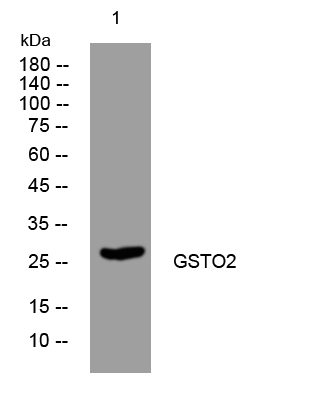GSTO2 rabbit pAb
- Catalog No.:YT7139
- Applications:WB
- Reactivity:Human;Mouse;Rat
- Target:
- GSTO2
- Fields:
- >>Glutathione metabolism;>>Metabolism of xenobiotics by cytochrome P450;>>Drug metabolism - cytochrome P450;>>Drug metabolism - other enzymes;>>Metabolic pathways;>>Platinum drug resistance;>>Pathways in cancer;>>Chemical carcinogenesis - DNA adducts;>>Chemical carcinogenesis - receptor activation;>>Chemical carcinogenesis - reactive oxygen species;>>Hepatocellular carcinoma;>>Fluid shear stress and atherosclerosis
- Gene Name:
- GSTO2
- Protein Name:
- GSTO2
- Human Gene Id:
- 119391
- Human Swiss Prot No:
- Q9H4Y5
- Mouse Gene Id:
- 68214
- Mouse Swiss Prot No:
- Q8K2Q2
- Rat Gene Id:
- 100909560
- Rat Swiss Prot No:
- Q6AXV9
- Immunogen:
- Synthesized peptide derived from human GSTO2 AA range: 70-120
- Specificity:
- This antibody detects endogenous levels of GSTO2 at Human/Mouse/Rat
- Formulation:
- Liquid in PBS containing 50% glycerol, 0.5% BSA and 0.02% sodium azide.
- Source:
- Polyclonal, Rabbit,IgG
- Dilution:
- WB 1:500-2000
- Purification:
- The antibody was affinity-purified from rabbit antiserum by affinity-chromatography using epitope-specific immunogen.
- Concentration:
- 1 mg/ml
- Storage Stability:
- -15°C to -25°C/1 year(Do not lower than -25°C)
- Molecular Weight(Da):
- 27kD
- Background:
- The protein encoded by this gene is an omega class glutathione S-transferase (GST). GSTs are involved in the metabolism of xenobiotics and carcinogens. Four transcript variants encoding different isoforms have been found for this gene.[provided by RefSeq, Jul 2010],
- Function:
- catalytic activity:RX + glutathione = HX + R-S-glutathione.,similarity:Belongs to the GST superfamily. Omega family.,similarity:Contains 1 GST C-terminal domain.,similarity:Contains 1 GST N-terminal domain.,tissue specificity:Expressed in a range of tissues, including the liver, kidney, skeletal muscle and prostate. Strongest expression in the testis.,
- Subcellular Location:
- cytoplasm,cytosol,extracellular exosome,
- Expression:
- Expressed in a range of tissues, including the liver, kidney, skeletal muscle and prostate. Strongest expression in the testis.
- June 19-2018
- WESTERN IMMUNOBLOTTING PROTOCOL
- June 19-2018
- IMMUNOHISTOCHEMISTRY-PARAFFIN PROTOCOL
- June 19-2018
- IMMUNOFLUORESCENCE PROTOCOL
- September 08-2020
- FLOW-CYTOMEYRT-PROTOCOL
- May 20-2022
- Cell-Based ELISA│解您多样本WB检测之困扰
- July 13-2018
- CELL-BASED-ELISA-PROTOCOL-FOR-ACETYL-PROTEIN
- July 13-2018
- CELL-BASED-ELISA-PROTOCOL-FOR-PHOSPHO-PROTEIN
- July 13-2018
- Antibody-FAQs
- Products Images

- Western blot analysis of lysates from HuvEc cells, primary antibody was diluted at 1:1000, 4°over night



